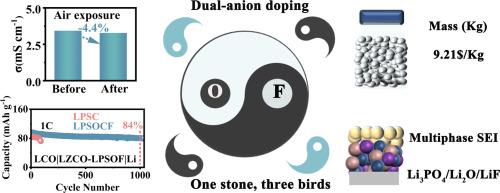低成本、高空气稳定性的银柱石电解质在全固态锂金属电池中提供优异的界面兼容性
IF 20.2
1区 材料科学
Q1 CHEMISTRY, PHYSICAL
引用次数: 0
摘要
银柱石Li6PS5Cl (LPSC)固体电解质由于其高离子电导率和机械稳健性,在全固态锂电池中显示出巨大的前景,但它们面临三个关键挑战:高生产成本,与锂阳极的有害界面反应,以及空气稳定性差。本文研制了一种氧氟共掺杂银汞石电解质Li5.5PS2.5O2Cl1.4F0.1 (LPSOCF)。战略性前体选择将LPSOCF的材料成本降低到仅为LPSC的3.65%,促进了公斤级合成,标志着迈向商业化的关键一步。氧和氟的加入稳定了PS43-四面体框架,降低了水吸附能,使电解质的空气稳定性显著增强(在10%湿度下暴露10h后,其原有离子电导率仍保持95.6%)。同时,氧和氟的协同掺杂诱导电解质与锂金属阳极之间原位形成Li2O/LiF/Li3PO4多组分界面层,显著增强了全固态锂金属电池的界面稳定性。因此,锂|LPSOCF|锂对称电池达到4.5 mA cm-2的临界电流密度(CCD),并在2800小时内表现出稳定的锂电镀/剥离。此外,Li|LPSOCF-Li2.5ZrCl5.5O0.5 |LiCoO2电池在0.5℃下循环635次后保持80%的初始容量,在1C下循环1000次后保持84%的初始容量。这项工作为银柱石电解质在全固态电池中可扩展的商业部署奠定了基础。本文章由计算机程序翻译,如有差异,请以英文原文为准。

Low-Cost High-Air-Stability Argyrodite Electrolyte Delivering Excellent Interface Compatibility in All-Solid-State Lithium Metal Batteries
Argyrodite Li6PS5Cl (LPSC) solid electrolytes have shown great promise for all-solid-state lithium batteries owing to their high ionic conductivity and mechanical robustness, yet they face three critical challenges: high production costs, detrimental interfacial reactions with lithium anodes, and poor air stability. In this work, an oxygen and fluorine co-doped argyrodite electrolyte Li5.5PS2.5O2Cl1.4F0.1 (LPSOCF) is developed. Strategic precursor selection lowers the material cost of LPSOCF to only 3.65% that of LPSC, facilitating kilogram-scale synthesis and marking a critical step towards commercialization. The incorporation of oxygen and fluorine stabilizes the PS43- tetrahedral framework and decreases the water adsorption energy, endowing the electrolyte with markedly enhanced air stability (retaining 95.6% of its original ionic conductivity after 10h exposure to 10% humidity). Meanwhile, the synergistic doping of oxygen and fluorine induces the in-situ formation of a Li2O/LiF/Li3PO4 multicomponent interface layer between the electrolyte and the lithium metal anode, conspicuously bolstering interface stability in the all-solid-state lithium metal batteries. Consequently, the Li|LPSOCF|Li symmetric batteries achieve a critical current density (CCD) of 4.5 mA cm-2 and exhibit stable lithium plating/stripping over 2800 hours. Furthermore, the Li|LPSOCF-Li2.5ZrCl5.5O0.5 |LiCoO2 batteries retain 80% of their initial capacity after 635 cycles at 0.5C and 84% after 1000 cycles at 1C. This work constitutes a cornerstone for the scalable commercial deployment of argyrodite electrolytes in all-solid-state batteries.
求助全文
通过发布文献求助,成功后即可免费获取论文全文。
去求助
来源期刊

Energy Storage Materials
Materials Science-General Materials Science
CiteScore
33.00
自引率
5.90%
发文量
652
审稿时长
27 days
期刊介绍:
Energy Storage Materials is a global interdisciplinary journal dedicated to sharing scientific and technological advancements in materials and devices for advanced energy storage and related energy conversion, such as in metal-O2 batteries. The journal features comprehensive research articles, including full papers and short communications, as well as authoritative feature articles and reviews by leading experts in the field.
Energy Storage Materials covers a wide range of topics, including the synthesis, fabrication, structure, properties, performance, and technological applications of energy storage materials. Additionally, the journal explores strategies, policies, and developments in the field of energy storage materials and devices for sustainable energy.
Published papers are selected based on their scientific and technological significance, their ability to provide valuable new knowledge, and their relevance to the international research community.
 求助内容:
求助内容: 应助结果提醒方式:
应助结果提醒方式:


